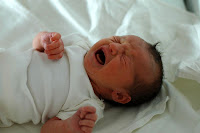This blog has moved to a new website
Nutrition, Health & Wellness
Home > Tears in newborn > Blocked tear ducts in newborn
Tears are secretions by lacrimal gland, meibomian glands (or tarsal glands) and conjunctival goblet cells in the eyes. Tears are for cleaning, protecting, moisturizing and lubricating the eyes. Production of tears is a continuous process and newborns also have functional lacrimation.
When we blink these secretions are smeared on the eye and the excess is pushed towards the tear ducts in the inner corners of the eyes. There, these secretions get collected in the nasolacrimal sac and are emptied into nose through nasolacrimal tubes.
Causes of blocked tear ducts in newborns
As the lacrimation is a continuous process, the excess fluids have to find a way out and it is usually through the tear ducts. About 20-30% of the newborns have blocked or under developed tear drain ducts.The condition of blocked tear drain tubes at birth is known as congenital nasolacrimal duct obstruction (congenital dacryostenosis). This condition can affect just one eye or both and in most of the cases it is due to a small thin membrane obstructing the opening. With the growth of the youngster there is spontaneous natural remission of the blocked condition in about 9-12 months in 90% of the cases.
In the case of under developed nasolacrimal tubules, with the growth of youngster, the nasolacrimal tubes also extend and grow to establish connection with the nasal cavity.
Certain other blocked conditions are encountered in a few newborns. They may occur in the following situations.
- Blocked lacrimal gland or nasolacrimal tube due to infections.
- Injuries to bone and tissues around the nasolacrimal tube.
- Thickening or inflammation of the nasolacrimal tube lining.
- Inflammation of the nasal cavity lining.
- Sinusitis.
- Conjunctivitis.
- Polyps and tumors in the nasal cavity.
- Abnormal growth of nasal bone putting pressure on the nasolacrimal tube.
- Closed, undeveloped or undeveloped holes (puncta) in the inner corners of the eyes.
Symptoms of blocked tear ducts in newborns
If the nasolacrimal tubule is not fully developed, not yet connected or blocked the excess fluid make the eyes appear flooded and newborn tears may trickle down the cheeks. This may happen even when the s/he is not crying. In the first four weeks as the secretions are minimal, flooding of eyes may not be apparent.Crusty eyes and sticky and matted eyelashes are tell-tale signs of blocked tear ducts. Mucin produced by the glands gets deposited at the corner of the eyes and also makes the eyelids sticky. Bacteria start growing on these deposits and cause eye infection leading to irritation and reddening of the eyes. The stagnated tears in the nasolacrimal sacs may also become a focal point for bacterial growth and lead to swollen sacs. Infection of nasolacrimal sac is known as dacryocystitis. Fever with tenderness and swelling near the nose bridge on the affected side may be experienced.
Remedies for blocked tear ducts in newborns
Usually the conditions with blocked tear ducts do not require treatment as in most of the cases they open up by their first birthday.However they must be continuously Observed with no intervention to avoid possibilities of complications.
The pediatrician may advise nasolacrimal massage to be repeated a number times in a day.
The pediatrician may also advise cleaning the discharge and crust with clean, soft, wet and warm cloth.
If infection is suspected, antibiotic eye drops may be prescribed.
If the infection spreads and involves nasolacrimal sacs or conjunctiva, oral antibiotics may also be prescribed.
If the blocked condition persists beyond nine months, pediatric ophthalmologist may resort to probing procedure for clearing and opening up tear drain tubes.
Surgical procedures may be resorted to, if there are structural anomalies or abnormal growths.
As there are possibilities of medical complications in blocked tear duct in newborns, it is necessary that if you suspect this condition, bring it to the notice of your pediatrician for medical evaluation.
Related topics in Daily Health News & Tips:
Newborn tears.
Newborn tears.
Interesting topics in Daily Health News & Tips:
- Social anxiety depression - Social anxiety disorder causes.
- Horseradish roots - Horseradish juice - Health Benefits.
- Severe hypothyroidism - side effects of hypothyroidism disorder.
- Chronic sinusitis treatment - balloon sinuplasty.
- Cloves (Syzygium aromaticum) - Health benefits of cloves.
- Prevent back pain in children from heavy backpacks.
- Celery juice nutrients - Health benefits.
